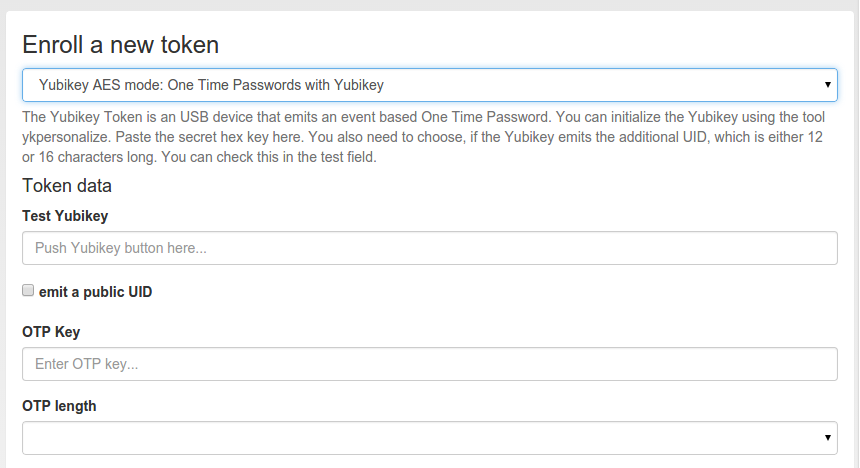4.4.2.17. Yubikey¶
The Yubikey is initialized with privacyIDEA and works in Yubicos own AES mode. It outputs a 44 character OTP value, consisting of a 12 character prefix and a 32 character OTP. But in contrast to the Yubico Cloud mode, in this mode the secret key is contained within the token and your own privacyIDEA installation.
If you have the time and care about privacy, you should prefer the Yubikey AES mode over the Yubico Cloud mode.
There are three possible ways to enroll a Yubikey token.
Note
We recommend that you use the privacyidea command line
client, to initialize the Yubikeys. You can use the mass enrollment, which
eases the process of initializing a whole bunch of tokens.
Run the command like this:
privacyidea -U https://your.privacyidea.server -a admin token \
yubikey_mass_enroll --yubimode YUBICO
This command initializes the token and stores the AES secret and prefix
in privacyidea, so the token is immediatly useful. You can choose the slot
with --yubislot. For further help call
privcyidea yubikey_mass_enroll with the --help option.
The second way to enroll a yubikey token is also using yubikey_mass_enroll,
but with the option --filename to write to token configuration into the
specified file. The resulting file can then be imported into privacyidea:
Select Tokens -> Import Tokens, select “OATH CSV” and the file you just created.
Third and last you can use this dialog to enroll a Yubikey AES mode token, if you have initialized the yubikey with the external ykpersonalize tool.
4.4.2.17.1. Redirect api url to privacyideas /ttype/yubikey¶
Yubico servers use /wsapi/2.0/verify as the path in the
validation URL. Some tools (e.g. Kolab 2fa) let the
user/admin change the api host, but not the rest of
the URL. Let’s redirect the api URL to privacyideas
/ttype/yubikey - you’ll need to enable the following two
lines in /etc/apache2/site-enabled/privacyidea.conf:
RewriteEngine on RewriteRule “^/wsapi/2.0/verify” “/ttype/yubikey” [PT]
If you use nginx there is a similar line provided as a comment to the nginx configuration as well.

